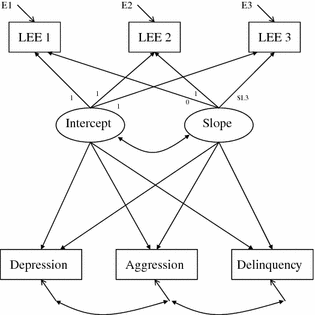The predictive capacity of perceived expressed emotion as a dynamic entity of adolescents from the general community
- PMID: 20364246
- PMCID: PMC3092936
- DOI: 10.1007/s00127-010-0218-y
The predictive capacity of perceived expressed emotion as a dynamic entity of adolescents from the general community
Abstract
Background: In previous studies, it has been demonstrated that high parental expressed emotion (EE) is predictive of depressive, aggressive and delinquency symptoms of adolescents. Two issues have received much less prominence in EE research, these being studies of adolescent perceived EE and the measurement of the EE as a dynamic, developmental construct. This 4-year, three-wave, longitudinal study of perceived EE of adolescents from the general community examines if adolescent perceived EE measured with the traditional, one-measurement EE approach as well as adolescent perceived EE measured with a repeated measured, dynamic EE approach can predict adolescent depressive, aggressive and delinquency symptoms.
Methods: Dutch adolescents (N = 285; 51% girls; M = 13 years) from the general community were prospectively studied annually for 4 years. At all waves, the adolescents completed the Level of Expressed Emotion (LEE) questionnaire and at the final wave also completed self-rated measures of depressive, aggressive and delinquent symptoms. Growth models were used to predict adolescent symptoms from adolescent perceived EE.
Results: Growth models significantly predicted adolescent depressive, aggressive and delinquency symptoms from adolescent perceived EE.
Conclusions: This study of the LEE demonstrates that developmental characteristics of EE are predictive of adolescents' symptoms. These findings hold implications for current EE intervention therapies and the conceptualization of EE.
Figures
Similar articles
-
How does longitudinally measured maternal expressed emotion affect internalizing and externalizing symptoms of adolescents from the general community?J Child Psychol Psychiatry. 2011 Nov;52(11):1174-83. doi: 10.1111/j.1469-7610.2011.02400.x. Epub 2011 Mar 14. J Child Psychol Psychiatry. 2011. PMID: 21401595
-
The moderating role of empathy in the association between parental support and adolescent aggressive and delinquent behavior.Aggress Behav. 2012 Sep-Oct;38(5):368-77. doi: 10.1002/ab.21435. Epub 2012 Jul 2. Aggress Behav. 2012. PMID: 22898874
-
Does the level of expressed emotion (LEE) questionnaire have the same factor structure for adolescents as it has for adults?Soc Psychiatry Psychiatr Epidemiol. 2007 Mar;42(3):215-20. doi: 10.1007/s00127-006-0145-0. Epub 2007 Jan 31. Soc Psychiatry Psychiatr Epidemiol. 2007. PMID: 17268763 Free PMC article.
-
Perceived Expressed Emotion in Adolescents with Binge-Eating Disorder.J Abnorm Child Psychol. 2015 Oct;43(7):1369-77. doi: 10.1007/s10802-015-0015-x. J Abnorm Child Psychol. 2015. PMID: 25860811
-
Trajectories of maternal verbal aggression across the middle school years: associations with negative view of self and social problems.Child Abuse Negl. 2011 Oct;35(10):814-30. doi: 10.1016/j.chiabu.2011.06.001. Epub 2011 Oct 20. Child Abuse Negl. 2011. PMID: 22018517 Review.
Cited by
-
Mother and adolescent expressed emotion and adolescent internalizing and externalizing symptom development: a six-year longitudinal study.Eur Child Adolesc Psychiatry. 2016 Jun;25(6):615-24. doi: 10.1007/s00787-015-0772-7. Epub 2015 Sep 29. Eur Child Adolesc Psychiatry. 2016. PMID: 26419776 Free PMC article.
-
The Relationship Between Adolescents' Perception of Family Emotional Atmosphere and Acne Severity, Self-Esteem, and Quality of Life in Adolescents Diagnosed with Acne Vulgaris.Turk Arch Pediatr. 2023 Nov;58(6):646-652. doi: 10.5152/TurkArchPediatr.2023.23111. Turk Arch Pediatr. 2023. PMID: 37915273 Free PMC article.
-
Family Conflict, Perceived Criticism, and Aggression in Symptomatic Offspring of Parents With Mood Disorders: Results From a Clinical Trial of Family-Focused Therapy.JAACAP Open. 2024 Feb 28;3(1):73-84. doi: 10.1016/j.jaacop.2024.01.008. eCollection 2025 Mar. JAACAP Open. 2024. PMID: 40109484 Free PMC article.
-
The path from schizotypy to depression and aggression and the role of family stress.Eur Psychiatry. 2020 Jul 30;63(1):e79. doi: 10.1192/j.eurpsy.2020.76. Eur Psychiatry. 2020. PMID: 32727629 Free PMC article.
-
Brief report: Borderline personality symptoms and perceived caregiver criticism in adolescents.J Adolesc. 2015 Jun;41:157-61. doi: 10.1016/j.adolescence.2015.03.009. Epub 2015 Apr 16. J Adolesc. 2015. PMID: 25889821 Free PMC article.
References
-
- Asarnow JR, Goldstein MJ, Tompson M, Guthrie D. One-year outcomes of depressive disorders in child psychiatric in-patients: evaluation of the prognostic power of a brief measure of expressed emotion. J Child Psychol Psychiatry. 1993;34:129–137. doi: 10.1111/j.1469-7610.1993.tb00975.x. - DOI - PubMed
-
- Asarnow JR, Tompson M, Hamilton EB, Goldstein MJ, Guthrie D. Family expressed emotion, childhood-onset depression, and childhood-onset schizophrenia spectrum disorders: is expressed emotion a nonspecific correlate of child psychopathology or a specific risk factor for depression? J Abnorm Child Psychol. 1994;22:129–146. doi: 10.1007/BF02167896. - DOI - PubMed
Publication types
MeSH terms
LinkOut - more resources
Full Text Sources
Medical


